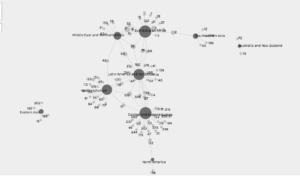How do we transcend cynicism to embrace hope and love in our politics during these tough times? How do we help this generation of organizers consider not only what they are fighting against but what they are fighting for? These are the guiding questions of my digital humanities project proposal. For the final project, I proposed a website that is open for people to imagine the world of their wildest dreams, where they are truly free, consider the steps it would take to reach that world, and find local resources to aid in the journey toward that freedom dream. Freedom dreaming as I have defined it is the act of first envisioning the future you want to see and second contemplating the steps it will take to get to that vision. I hope for this website to be a community space where people can share ideas and resources to help get us all to a better tomorrow.
The website will be made with undergrad and high school students in mind and have three main components. The first would be selected texts from POC radical thinkers of the past. Themes will be pulled out through text analysis to serve as inspiration for visitors to the site. Second, is the social media aspect. Visitors to the site will be invited to share their freedom dreams on Twitter. Given a longer period of time I would look into using instagram to include visual and sound art, but given time constraints of a semester I think it will be best to stick with text. The third component will be a section with online resources and local organizations that can help people realize their freedom dreams.
Guiding principles that I will keep in mind as I create this website are as follows:
- Freedom Dreaming means actively uplifting the intricately connected and complex lives and stories of Black, Brown, Indigenous, Asian/Pacific Islander, Latin/os/as/x, Arab, Middle Eastern and Multi-ethnic people
- Freedom Dreaming is about affirming and respecting all levels of ability, gender identity, sexuality, age, stages of healing, and socio-economic class
- Freedom Dreaming is about connecting people and communities to create shared visions with one another
- Freedom Dreaming means acknowledging and harnessing your own intrinsic power and expertise
- Freedom Dreaming is about listening deeply while unlearning harmful ideologies and ideas
I think working on this project will prove both interesting and challenging. Thankfully there are resources on how to create accessible website that any user can use regardless of how they access the internet. I also had the idea while writing the proposal that something that might be interesting once the Twitter feed gets populated is text mining those posts using the Twitter API to see if any themes come out of it. I have no idea what it will show but I think it could be an interesting way of looking at what people feel are important topics that need to be discussed and things that are broken in our society that need to be fixed. It might also be good to compare and contrast our freedom dreams today with those of previous generations.




